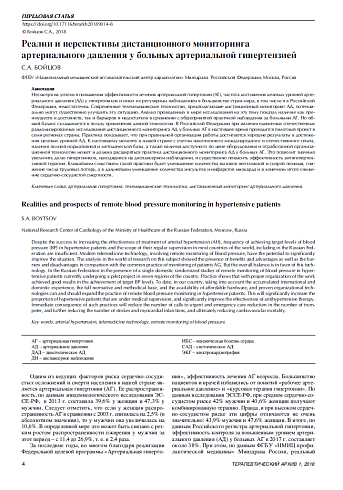Реалии и перспективы дистанционного мониторинга артериального давления у больных артериальной гипертензией - Журнал Терапевтический архив №1 Поликлинические проблемы и организация медицинской помощи 2018
Реалии и перспективы дистанционного мониторинга артериального давления у больных артериальной гипертензией
Материалы доступны только для специалистов сферы здравоохранения.
Чтобы посмотреть материал полностью
Авторизуйтесь
или зарегистрируйтесь.
Аннотация
Несмотря на успехи в повышении эффективности лечения артериальной гипертонии (АГ), частота достижения целевых уровней артериального давления (АД) у гипертоников и охват их регулярным наблюдением в большинстве стран мира, в том числе и в Российской Федерации, недостаточны. Современные телемедицинские технологии, предполагающие дистанционный мониторинг АД, потенциально могут существенно улучшить эту ситуацию. Анализ проведенных в мире исследований на эту тему показал наличие как преимуществ и достоинств, так и барьеров и недостатков в сравнении с общепринятой практикой наблюдения за больными АГ. Но общий баланс складывается в пользу применения данной технологии. В Российской Федерации при наличии единичных отечественных рандомизированных исследований дистанционного мониторинга АД у больных АГ в настоящее время проводится пилотный проект в семи регионах страны. Практика показывает, что при правильной организации работы достигаются хорошие результаты в достижении целевых уровней АД. К настоящему моменту в нашей стране с учетом накопленного международного и отечественного опыта, наличия полной нормативной и методической базы, а также наличия доступного по цене оборудования и отработанной организационной технологии может и должна расширяться практика дистанционного мониторинга АД у больных АГ. Это позволит значимо увеличить долю гипертоников, находящихся на диспансерном наблюдении, и существенно повысить эффективность антигипертензивной терапии. Ближайшим следствием такой практики будет уменьшение количества вызовов неотложной и скорой помощи, снижение числа трудовых потерь, а в дальнейшем уменьшение количества инсультов и инфарктов миокарда и в конечном итоге снижение сердечно-сосудистой смертности.
Ключевые слова: артериальная гипертония, телемедицинские технологии, дистанционный мониторинг артериального давления.
Key words: arterial hypertension, telemedicine technology, remote monitoring of blood pressure.
Ключевые слова: артериальная гипертония, телемедицинские технологии, дистанционный мониторинг артериального давления.
________________________________________________
Key words: arterial hypertension, telemedicine technology, remote monitoring of blood pressure.
Список литературы
1. Duan Y, Xie Z, Dong F, et al. Journal of Human Hypertension. 2017; 31: 427–437. doi:10.1038/jhh.2016.99
2. Mileski M, Scott Kruse C, Catalani J, Haderer T. Adopting Telemedicine for the Self-Management of Hypertension: Systematic Review. JMIR Med Inform. 2017 Oct-Dec; 5(4): e41. doi: 10.2196/medinform.6603
3. Посненкова О.М., Коротин А.С., Киселев А.Р., Гриднев В.И. Оценка эффективности технологии дистанционного мониторинга артериального давления у больных артериальной гипертонией на основе показателей выполнения клинических рекомендаций. Качество в кардиологии. 2015; 2: 1-5. [Posnenkova OM, Korotin AS, Kiselev AR, Gridnev VI. Evaluation the effectiveness of remote blood pressure monitoring technology in patients with hypertension on the basis of clinical recommendations performance measures. Kachestvo v kardiologii. 2015;2:1-5. (In Russ.)]. doi:10.15275/cardioit.2015.0203.
2. Mileski M, Scott Kruse C, Catalani J, Haderer T. Adopting Telemedicine for the Self-Management of Hypertension: Systematic Review. JMIR Med Inform. 2017 Oct-Dec; 5(4): e41. doi: 10.2196/medinform.6603
3. Posnenkova OM, Korotin AS, Kiselev AR, Gridnev VI. Evaluation the effectiveness of remote blood pressure monitoring technology in patients with hypertension on the basis of clinical recommendations performance measures. Kachestvo v kardiologii. 2015;2:1-5. (In Russ.) doi:10.15275/cardioit.2015.0203.
2. Mileski M, Scott Kruse C, Catalani J, Haderer T. Adopting Telemedicine for the Self-Management of Hypertension: Systematic Review. JMIR Med Inform. 2017 Oct-Dec; 5(4): e41. doi: 10.2196/medinform.6603
3. Посненкова О.М., Коротин А.С., Киселев А.Р., Гриднев В.И. Оценка эффективности технологии дистанционного мониторинга артериального давления у больных артериальной гипертонией на основе показателей выполнения клинических рекомендаций. Качество в кардиологии. 2015; 2: 1-5. [Posnenkova OM, Korotin AS, Kiselev AR, Gridnev VI. Evaluation the effectiveness of remote blood pressure monitoring technology in patients with hypertension on the basis of clinical recommendations performance measures. Kachestvo v kardiologii. 2015;2:1-5. (In Russ.)]. doi:10.15275/cardioit.2015.0203.
________________________________________________
2. Mileski M, Scott Kruse C, Catalani J, Haderer T. Adopting Telemedicine for the Self-Management of Hypertension: Systematic Review. JMIR Med Inform. 2017 Oct-Dec; 5(4): e41. doi: 10.2196/medinform.6603
3. Posnenkova OM, Korotin AS, Kiselev AR, Gridnev VI. Evaluation the effectiveness of remote blood pressure monitoring technology in patients with hypertension on the basis of clinical recommendations performance measures. Kachestvo v kardiologii. 2015;2:1-5. (In Russ.) doi:10.15275/cardioit.2015.0203.
Авторы
С.А. БОЙЦОВ
ФГБУ «Национальный медицинский исследовательский центр кардиологии» Минздрава Российской Федерации, Москва, Россия
National Research Center of Cardiology of the Ministry of Healthcare of the Russian Federation, Moscow, Russia
ФГБУ «Национальный медицинский исследовательский центр кардиологии» Минздрава Российской Федерации, Москва, Россия
________________________________________________
National Research Center of Cardiology of the Ministry of Healthcare of the Russian Federation, Moscow, Russia
Цель портала OmniDoctor – предоставление профессиональной информации врачам, провизорам и фармацевтам.

